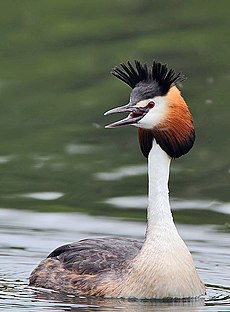Courtship in animals
Courtship in animals is the behaviour by which different species select their partners for reproduction. Usually, the male starts the courtship, and the female chooses to either mate or reject the male based on his "performance".
Many animals have mate-selection courtship rituals. Animal courtship may involve complicated dances or touching, vocalizations, or displays of beauty or fighting prowess. One animal whose courtship rituals are well studied is the bowerbird, whose male builds a "bower" of collected objects. Another is the Great Crested Grebe, whose courtship dances were first described by Julian Huxley.[1]
In cases like the Great Crested Grebe, the pairs form life (or at least long-lasting) partnerships. If pairs get separated, there are exceptionally vigorous dances when they come together. There are a number of "dance routines", which occur in the different circumstances of life. All this behaviour is inherited, though the individual bird remembers the place and the partner permanently.
It might be thought that courtship only occurs in the kind of animals which have fairly complex brains, such as mammals and birds. This is not the case. If the dance is not "correct" for that species, she refuses the male. This behaviour is clearly advantageous to the female, whose genes have a better chance of contributing to the next generation if her partner is biologically fit.[2] Drosophila are by no means the only insects which have rituals.[3]
- Males: their interest is to mate with a large number of completely faithful females, thus spreading their genes widely in the population.
- Females: their interest is to mate with a large number of fit males, thus producing a large number of fit and varied offspring.
This has many consequences.[4] In some insects the male injects a cocktail of chemicals in the together with the .[5] Also, some females can get rid of the previous male's .[6]
After has taken place, males do various things to stop the female again. What the male does depends on the species. In birds and mammals, the male may fight off other candidate males.[7][5][8]
Thus courtship is the visible part of a complex series of events whereby the males and females come together for . The continuation of pair-bonding after is common in birds and mammals because the survival of their genes depends on the fertilised eggs reaching maturity. If that requires support from both parents, the rituals are the way the pair keep connected.
Related pages
References
- ↑ Huxley, Julian 1914. The courtship habits of the Great Crested Grebe. Reprinted by Jonathan Cape, London 1968.
- ↑ Brookes, Martin 2001. Fly: the unsung hero of 20th-century science. New York: HarperCollins. p123–126 ISBN 0-06-621251-0
- ↑ Choe J.C. & Crespi B.I (eds) 1997. Cambridge University Press.
- ↑ Parker, Geoffrey A. 1970. Biological Reviews. 45: 525-567.
- ↑ 5.0 5.1 Schilthuizen, Menno 2001. Frogs, flies and dandelions: the making of species. Oxford University Press, p92. ISBN 019850392X
- ↑ Eberhard W.G. 1996. Female control: sexual selection by cryptic female choice. Princeton New Jersey: Princeton University Press.
- ↑ Arnqvist G. and Rowe L. 2005. Princeton, New Jersey: Princeton University Press,
- ↑ Crudgington H. & Siva-Jothy M.T. 2000. Nature. 407: 855-856.
[[en:Courts

